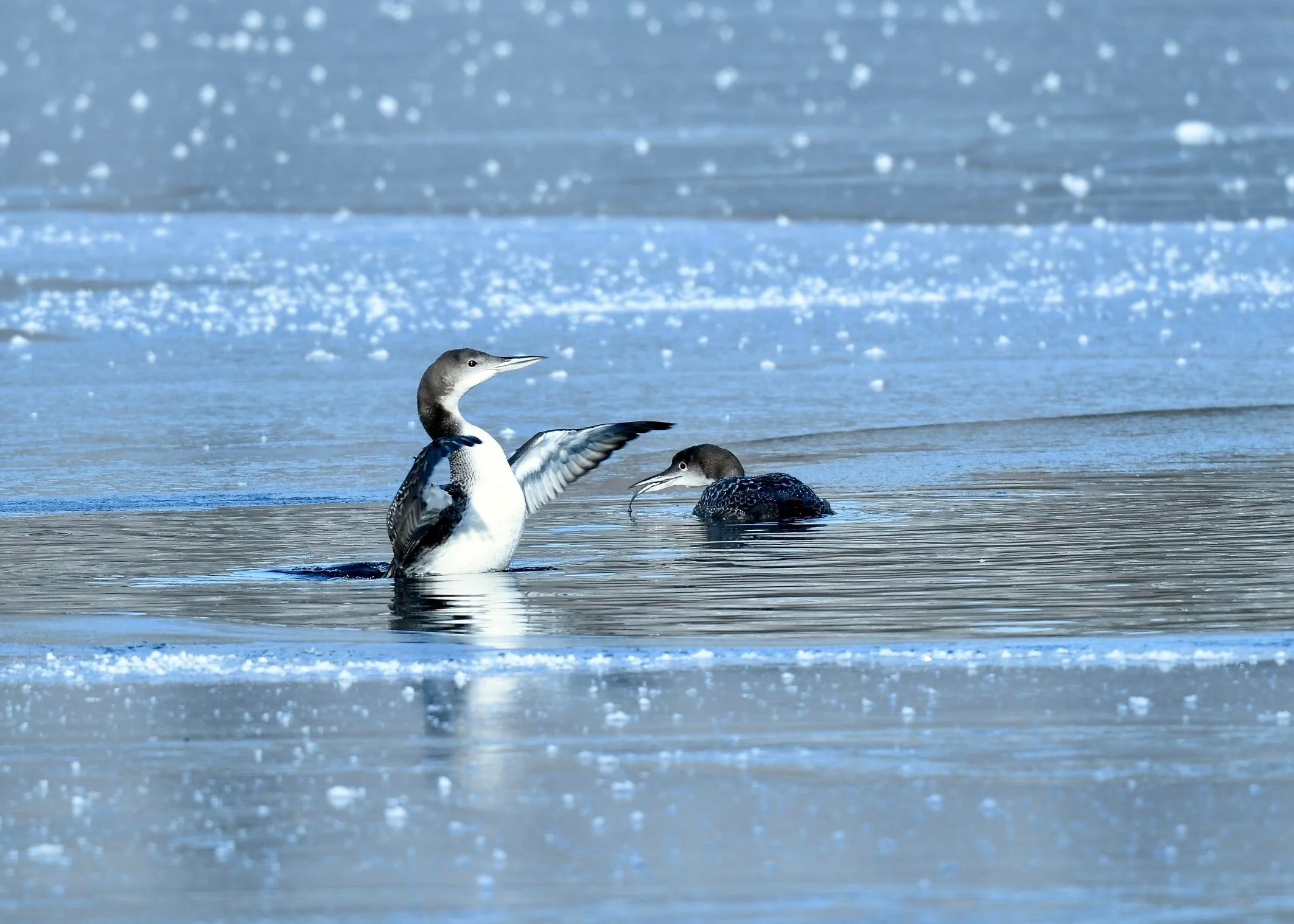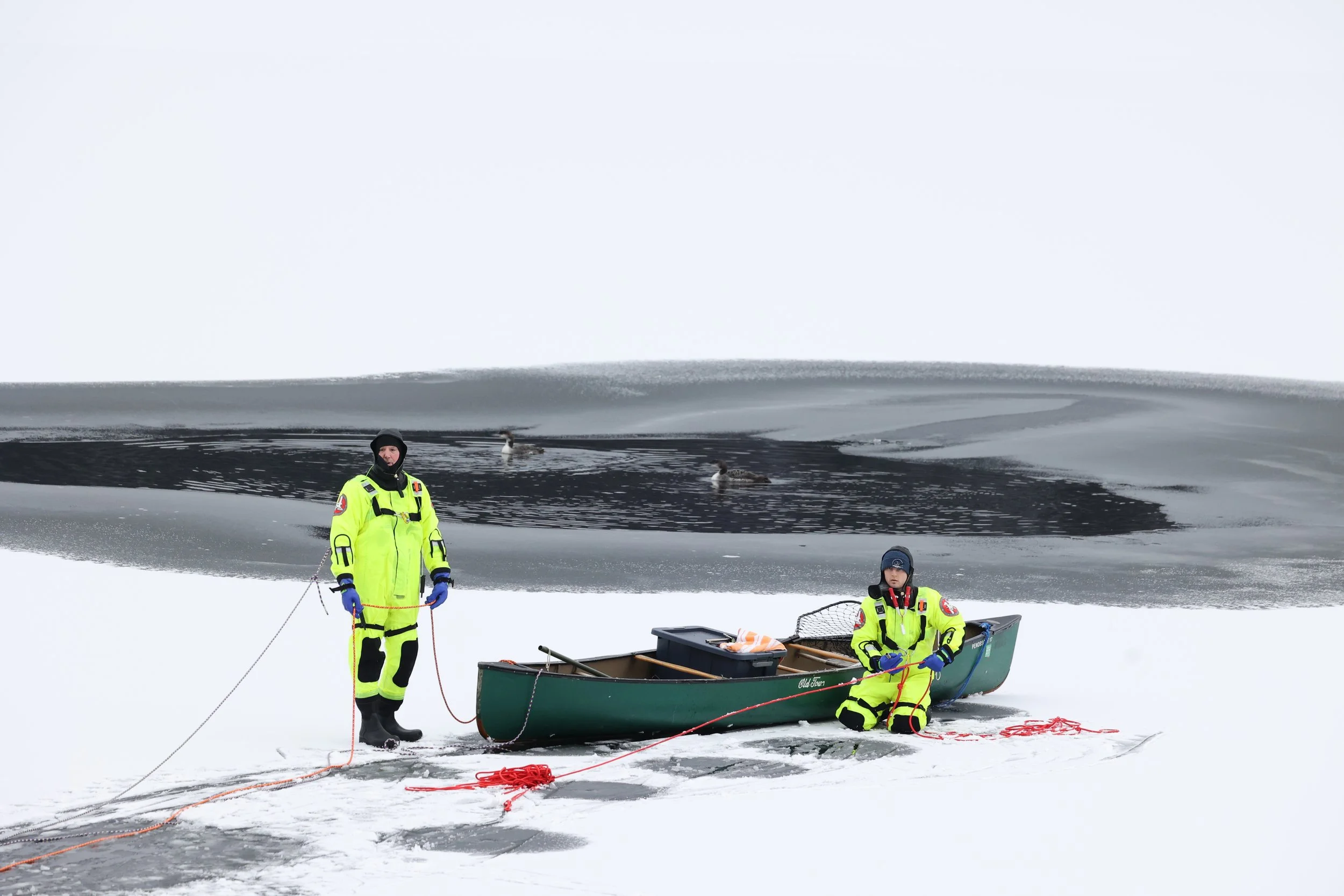Iced-In Loon Rescue on Fourth Lake
Loons trapped by the ice on Fourth Lake. Photo by Don Andrews.
On Saturday, December 14, Leslie and Michael Maurer observed and reported two juvenile loons that were iced-in, meaning they were confined to a small area of open water surrounded by ice, on Fourth Lake in Inlet, NY.
ACLC field staff and rescue volunteers Don Andrews and Gary Lee monitored the loon and ice conditions during the weekend, as initially the hole that the loons were confined in was too big for a rescue attempt and the ice was too thin to walk on.
As the hole closed up and ice began thickening on Sunday evening, a rescue attempt was planned for the morning of Monday, December 16. ACLC Executive Director Dr. Nina Schoch and Research Biologist Griffin Archambault met the Maurers at their residence along with a team of ACLC rescue volunteers that included Don Andrews, Gary Lee, Amy Sauer, Chris Clark, Terry Ryder, Kathy Phillips, Kurt Gardner, Ken Trotman and Matt Luppino. Because ice rescues are physically and logistically challenging, many shoreline volunteers are often needed to help transport gear, monitor the ice team, handle and process loons, document the attempt, and provide hands-on assistance to the ice crew, such as towing a boat back to shore.
Volunteer Don Andrews and ACLC Research Biologist Griffin Archambault tend to ice rescue gear. Photo by Nina Schoch.
Volunteer Don Andrews fell through the ice and had to climb to safety. Photo by Nina Schoch.
ACLC Research Biologist Griffin Archambault successfully nets one of the trapped loons. Photo by Nina Schoch.
Calling off the rescue attempt after failing to capture the second trapped loon. The second loon was able to fly off after temperatures warmed on Tuesday, December 17. Photo by Nina Schoch.
Don Andrews and Griffin Archambault ventured out on the ice to attempt the rescue, and were able to net one of the two juvenile loons after it crawled up onto the ice. Despite attempts with hand-held dip nets and gill nets, the second juvenile continuously evaded capture. With warm temperatures rolling in and weakening ice conditions, the rescue effort was called off. After almost 24 hours of melting following the rescue attempt, the hole had grown and the second juvenile that evaded capture was able to fly away on Tuesday, December 17.
Volunteer Don Andrews holds a rescued loon while ACLC Research Biologist Griffin Archambault takes measurements. Photo by Nina Schoch.
The loon that was rescued was given a physical exam, measured, sampled (blood and feather samples were taken), and banded before being driven to Lake Champlain for release. Lake Champlain was chosen as the release site because of the lack of ice despite cold temperatures. This loon will have plenty of food and open water to (hopefully) begin its first migration.
ACLC Executive Director Dr. Nina Schoch released the rescued loon on Lake Champlain.
It is thought that the two juvenile loons that were iced-in were siblings and chicks of a pair that occupied the same area of Fourth Lake this past summer. Common loon adults typically leave their breeding lakes several weeks before their chicks in the fall, so it is not uncommon to find chicks all alone on lakes late into the fall. These chicks must rely on instincts, environmental cues, and other inputs to begin their first migration. Luckily for these two loons, a rescue and a brief period of melting allowed them both to escape unscathed.
If you find an iced-in loon, please contact the Adirondack Center for Loon Conservation. Please note that we must wait for the hole to be small enough and the ice to be thick enough before attempting a rescue. The ACLC highly discourages anyone without the proper equipment, training and experience from attempting to rescue an iced-in loon on their own as ice rescues are dangerous and complex. The ACLC was able to purchase ice rescue equipment such as survival suits through a grant from the US Fish and Wildlife Service on behalf of the Bouchard Barge 120 Buzzards Bay Oil Spill Trustees.
The ACLC would like to extend a huge thank you to Leslie and Michael Maurer as well as the rescue volunteers that helped out: Don Andrews, Gary Lee, Amy Sauer, Chris Clark, Terry Ryder, Kathy Phillips, Kurt Gardner, Ken Trotman, and Matt Luppino. We could not have done this rescue without your support! If you are interested in becoming an ACLC rescue volunteer, including receiving training in ice rescues, please contact research@adkloon.org.
Words by Griffin Archambault, ACLC Research Biologist







